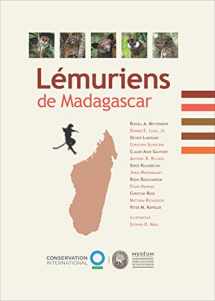
Lémuriens de Madagascar
ISBN-13:
9782856537473
ISBN-10:
2856537472
Edition:
Translation
Author:
Russell A. Mittermeier
Publication date:
2015
Publisher:
French National Museum Natural History
Format:
Hardcover
841 pages
FREE US shipping
Book details
ISBN-13:
9782856537473
ISBN-10:
2856537472
Edition:
Translation
Author:
Russell A. Mittermeier
Publication date:
2015
Publisher:
French National Museum Natural History
Format:
Hardcover
841 pages
Summary
Lémuriens de Madagascar (ISBN-13: 9782856537473 and ISBN-10: 2856537472), written by authors
Russell A. Mittermeier, was published by French National Museum Natural History in 2015.
With an overall rating of 3.6 stars, it's a notable title among other
books. You can easily purchase or rent Lémuriens de Madagascar (Hardcover) from BooksRun,
along with many other new and used
books
and textbooks.
And, if you're looking to sell your copy, our current buyback offer is $0.3.
Description
Although Madagascar represents less than 7% of the land mass of the most primate-rich country in the world, Brazil, this island nation ranks second in primate diversity, with 98 endemic species. Madagascar is also an ecologically fragile country where natural resources are eroding at an alarming rate. In 2012, the International Union for Conservation of Nature reported a dramatic increase in the number of endangered species of Madagascar’s native primates, the lemurs. With lemurs representing 15% of all known primate species and subspecies—20% of genera and 36% of families—the responsibility of the country in terms of conservation is tremendous. This French-language book summarizes the available data on the ecology, behavior, distribution, and conservation status of all 102 known species and subspecies of lemur. Early chapters also present an overview of the island’s geological history, trace the arrival of lemurs, describe extinct species, and offer details on their discovery, current study, and specific conservation issues; while the appendices contain many maps showing the topography of the island, its biogeographic regions, and plant areas, as well as a list of places where lemurs can be seen in their natural habitat and an extensive bibliography. Richly illustrated throughout and featuring a user-friendly design with quick-reference color-coded page edges for each of the five extant lemur families, this guide will both encourage further research and be an invaluable aid to eco-tourists and amateur primatologists seeking to identify lemurs in nature.


We would LOVE it if you could help us and other readers by reviewing the book
Book review

Congratulations! We have received your book review.
{user}
{createdAt}
by {truncated_author}


